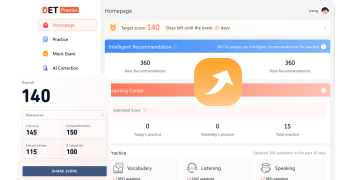인터랙티브 리스닝 쉽게 정복하기: 새로운 DET 문제 유형을 완벽히 파악하는 간단한 프레임워크
여러분, 안녕하세요. DET Practice에 오신 것을 환영합니다. 오늘은 "Interactive Listening" 문제를 푸는 방법에 대해 이야기하겠습니다. 일반적인 개선 방법을 안내하는 기사와 달리, 이 글에서는 매우 구체적이고 실행 가능한 조언과 단계들을 제공합니다. 꼼꼼히 읽어보시고, "Interactive Listening"에서 더 높은 점수를 얻으시길 바랍니다. 시작해볼까요!
문제 유형 소개
"Interactive Listening"은 2023년에 Duolingo English Test에 새롭게 도입된 문제 유형으로, 2025년에 업데이트되었습니다. 이 섹션에서는 순서대로 제시되는 여러 질문을 만나게 됩니다. 주요 문제 유형은 세 가지입니다:
1. 듣고 완성하기 (Listen and Complete): 이 파트에서는 짧은 상황 시나리오를 듣고, 3~4개의 빈칸 채우기 문항을 완성해야 합니다.
2. 듣고 답하기 (Listen and Respond): 이 파트는 객관식 문제로, 각각 4~5개의 선택지가 있습니다. 이 부분은 4분 안에 완료해야 합니다.
3. 대화 요약하기 (Summarize the Conversation): 여기서는 대화를 요약해야 하며, 답변 시간은 75초가 주어집니다.
"Interactive Listening"에 대해 더 자세히 알고 싶다면, 아래의 공식 소개 영상을 시청할 수 있습니다 (약 0:56부터 시작):
또한, 텍스트 버전을 읽고 싶으시다면, "Interactive Listening"에 대한 더욱 자세한 소개가 다른 게시글에도 있으니 참고하세요: https://www.detpractice.com/det-question-type-interactive-listening
참고: 이 가이드는 최신 내용으로 업데이트되었습니다. 최신 버전은 여기에서 확인할 수 있습니다: Duolingo English Test Interactive Listening – Complete Guide (새 버전)
Listen and Respond
TOEFL이나 IELTS의 리스닝 문제와 달리, DET의 "Interactive Listening" 문제에서는 들었던 스크립트가 점차적으로 화면에 표시됩니다. 네, 맞아요. 즉, 각 문제를 선택할 때 이전 힌트가 제공된다는 의미입니다. (좋은 소식이죠!)
l L문제 화면을 한번 살펴봅시다:
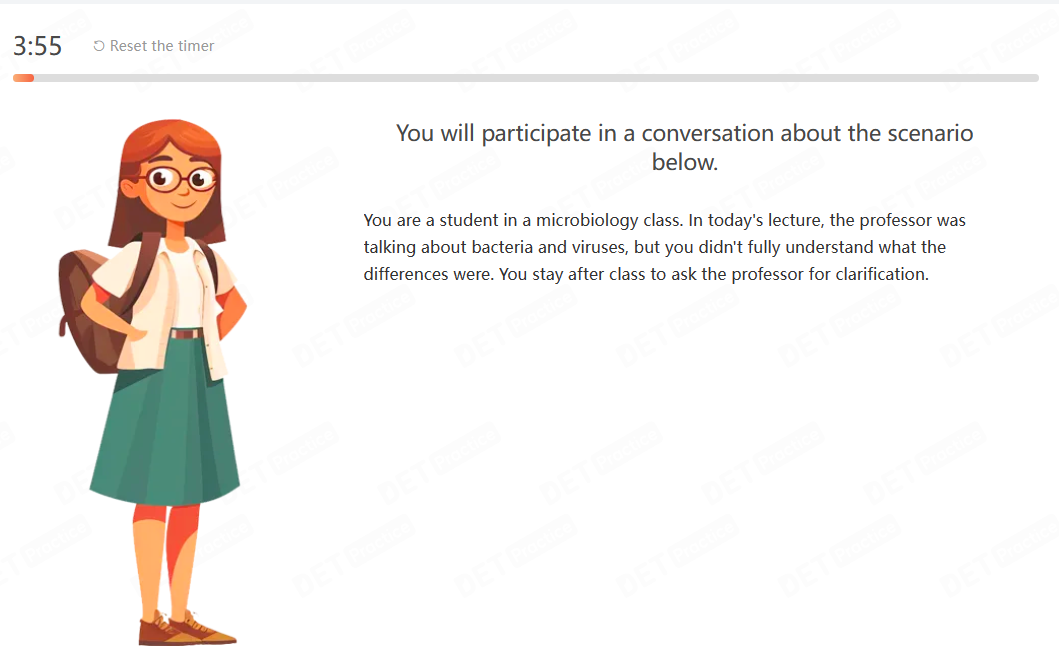
"Listen and Respond"를 풀기 전에 매번 다음과 같은 Scenario(상황)가 보입니다. 이 Scenario에서 어떤 정보를 얻을 수 있을까요:
a. 아래 시나리오와 관련된 대화에 참여하게 됩니다. (기존 청취 문제와 달리, 수험자인 여러분이 이 리스닝 세그먼트 내에서 한 역할을 맡게 됩니다.)
b. 여러분은 미생물학 수업의 학생입니다. (여러분의 신분을 알려줍니다.)
c. 오늘 강의를 마친 후, 교수님께 박테리아와 바이러스의 차이에 대해 질문합니다. (여러분이 겪은 문제와 도움을 요청한 상대를 나타냅니다.)
즉, 이 Scenario(상황)는 실제로 리스닝 스크립트를 요약한 형태라고 볼 수 있습니다(이 부분은 뒤에서 더 설명합니다). 따라서 Scenario를 "Listen and Respond" 문제 판단의 기준으로 삼을 수 있습니다.
l 예시 문제를 하나 살펴봅시다:
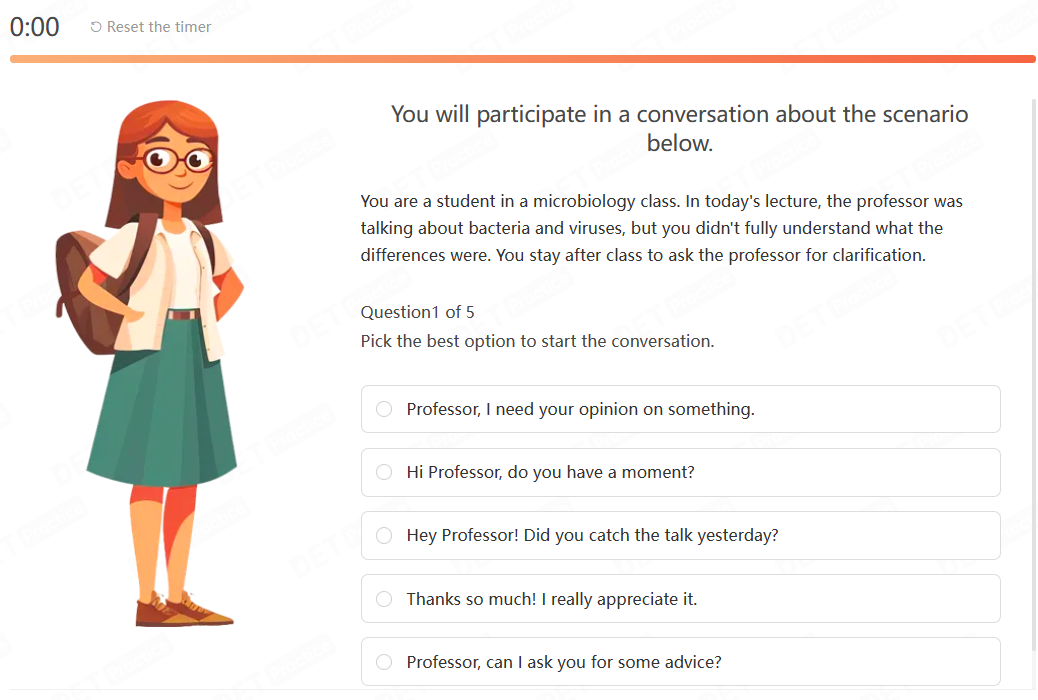
방금 본 Scenario를 빠르게 떠올려 봅시다. 이렇게 하면, 5번 선택지가 가장 적합한 답임을 알 수 있습니다.
l 계속해서 문제를 확인해봅시다:
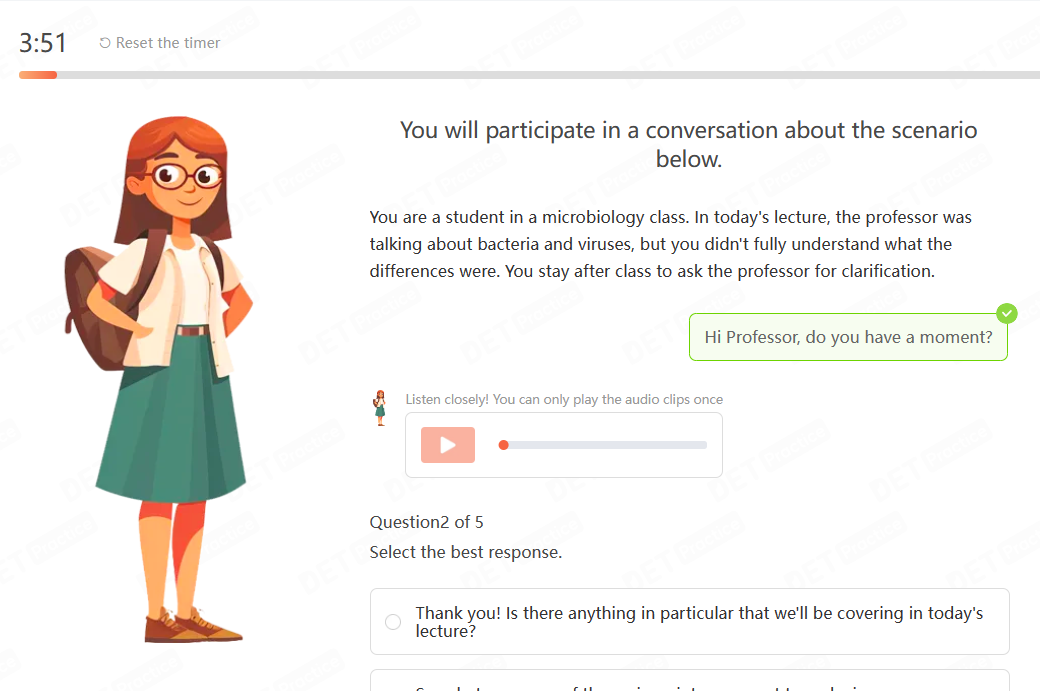
이 화면에서는 이전 선택 항목과 들었던 내용을 모두 볼 수 있습니다. 이는 수험자에게 매우 유용하며, 문제 풀이가 쉬워집니다.
어떻게 답을 고르면 좋을까요? 앞서 본 Scenario를 기억하세요. 예시들은 Scenario의 목적과 이후 제공되는 스크립트의 역할을 보여줍니다. 이러한 정보들이 앞으로의 객관식 문제 답변에 도움이 됩니다.
"Listen and Respond" 섹션이 끝나면 모든 리스닝 스크립트가 표시됩니다. 보통 1~2분이 남으니, 대화의 핵심 내용을 확인하고 암기하세요. 왜냐하면 가장 난이도 높은 문제, “Summarize the Conversation,이 곧 나오기 때문입니다.
Summarize the Conversation
먼저, 문제 화면을 살펴보겠습니다:
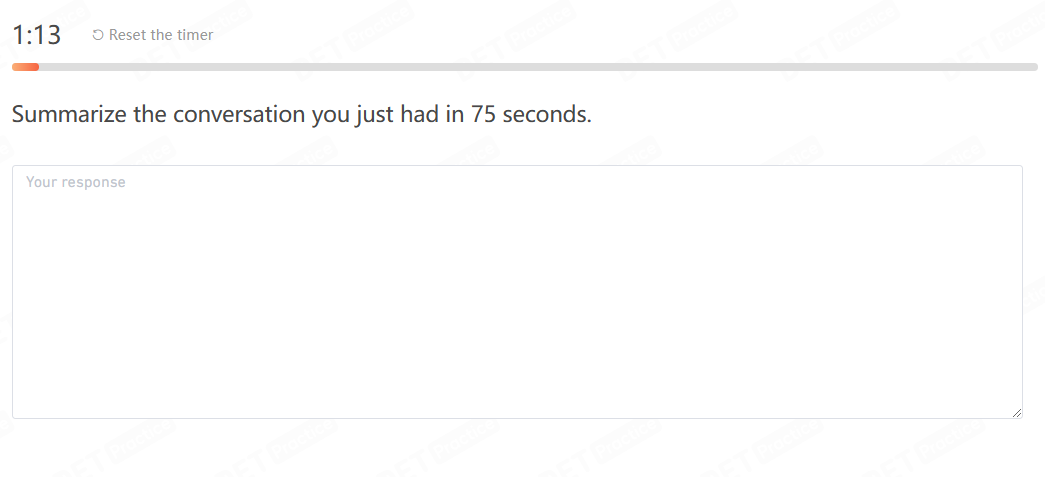
이 화면은 절박한 상황입니다. 이 인터페이스에는, 오직 75초 동안 답변해야 한다고만 알리고, 그 외 정보는 없습니다. 그렇습니다, 이전 리스닝 대화 내용을 다시 볼 수 없습니다. 따라서 오로지 기억에 의존해 대화 내용을 요약해 써야 합니다. 이 문제의 어려움은 단기 기억력과 빠른 타자 속도가 요구된다는 점입니다. 이 문제에서 최대한 많은 점수를 받으려면, 다음의 세 가지 디테일을 신경 써야 합니다:
1. 요약에서는 1인칭을 사용하세요
2. 과거 시제와 현재 시제가 가장 많이 쓰입니다
3. 리스닝 대화의 구체적인 내용을 최대한 포함시키세요
위 세 가지 사항에 대해 궁금하다면, Sample Essay를 참고하세요.

대부분의 수험생을 위한 답변 전략
l 단기 기억력이 좋지 않거나, 어휘력과 리스닝 능력이 모두 약하여 대화 내용을 충분히 이해하지 못한다면, Scenario에 집중할 것을 권장합니다. Scenario는 실제로 리스닝 대화를 요약한 것이며(일부 세부사항은 부족하지만), "Listen and Respond" 부분을 마친 후, 남은 시간에 Scenario를 집중적으로 암기하고 이후 요약 문제에서 복원하도록 해보세요. 물론 원문을 그대로 복사하기보다 여러분만의 표현으로 바꾸는 것이 가장 좋습니다.
l 타자 속도가 느리다면, typing.com 또는 keybr.com 사이트에서 하루 15~30분씩 타자 연습을 해보세요. 시험 준비 기간이 짧은 수험생이라면, "Interactive Listening" 작문 유형의 기본 틀이라도 미리 익혀두시기 바랍니다. 75초 안에 글쓰기 구조를 생각하다 보면 내용 작성이 어렵기 때문입니다.
I현재 영어 실력이 부족하다면, 제안드린 방법으로 연습하거나 문제를 풀어보시길 추천합니다. DET 시험에 좋은 결과 있길 바랍니다!
더 많은 DET 대비 전략을 보려면 여기를 클릭하세요.
오늘 바로 등록하여 DET 기출문제 뱅크 를 무료로 이용해보세요.






